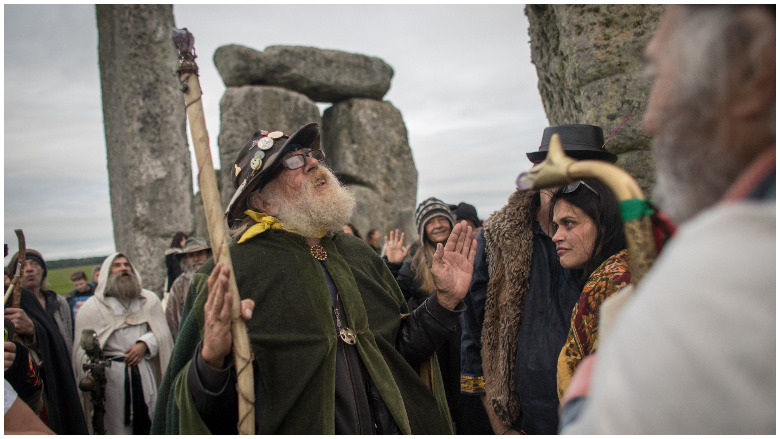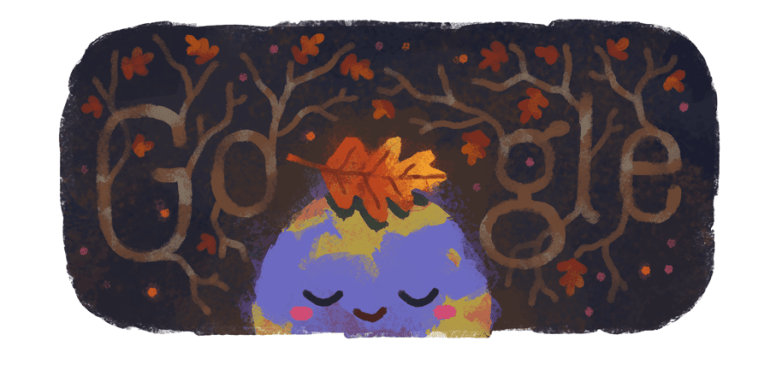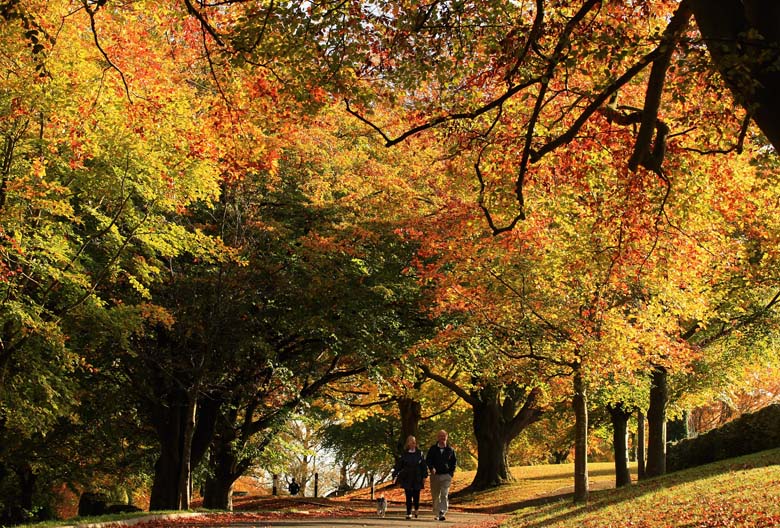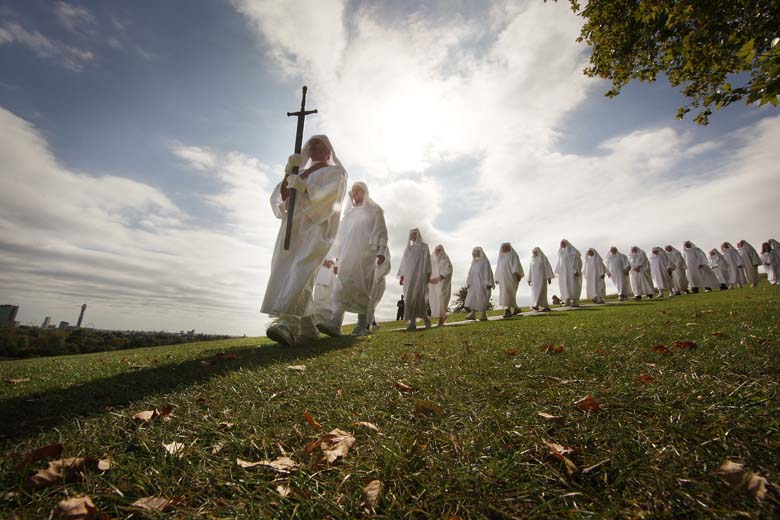
Fall season 2019 is upon us. Sorry to inform the summer lovers out there, but September 23 is officially the first day of fall, at least in the Northern Hemisphere. It’s the day the autumnal equinox arrives. With the equinox, though, come the festivities of autumn, many dating back centuries.
Google is celebrating the first day of fall with a Google Doodle and a quote from the English poet John Keats, who once wrote that fall is the “season of mists and mellow fruitfulness.” Google further quoted Keats: “To bend with apples the moss’d cottage trees / And fill all fruit with ripeness to the core.”
Incidentally, on the same day, Google is running a Google Doodle elsewhere in the world that celebrates the first day of spring in the Southern Hemisphere. For that Google Doodle, Google also turned to a poet: Chilean poet Pablo Neruda, who wrote, “Between water and light which unwind the air / Now the Spring is inaugurated / Now the seed is aware of its own growing.”
But why was September 23 chosen for the first day of the fall season in the Northern Hemisphere? What’s the history and traditions of what we now know as fall?

The Fall Season Google Doodle.
Here’s what you need to know about Fall 2019:
1. September 23, 2019 Is the Day of the Autumnal Equinox, the Start of the Fall Season

Matt Cardy/Getty ImagesWalkers pass trees showing their autumn colours on November 1, 2011 in Bath, England.
What is the autumnal equinox, which visits us on the first day of fall? According to Vox, “both the Northern and Southern hemispheres will experience an equal amount of daylight.” It’s also “the beginning of astronomical fall, with daylight hours continuing to shorten until the winter solstice in December,” Vox reported.
When does the equinox occur? Vox explains the phenomenon occurs at 3:50 a.m. Eastern on September 23, 2019 “when the sun is directly in line with the equator.”
According to History.com, the fall equinox heralds the first full day of fall, and it’s not on September 23 every year but always falls between September 21 and September 24.
Fall lasts until the winter solstice in December.
2. Many Cultures Have Rituals & Harvest Festivals Associated With the Arrival of Fall & the Autumn Equinox

Macdiarmid/Getty ImagesDruids celebrate the Autumn equinox on Primrose Hill on September 22, 2009 in London, England.
To many of the world’s cultures, there are stories, festivals, and other celebrations to mark the September equinox. Some of these are associated with the Harvest Moon which, in turn, is associated with the autumnal equinox and the arrival of fall.
For example, ancient Greeks believed that the goddess Persephone was returning to the underworld to join her husband Hades, History.com reported. In China, a harvest festival ignites around the Harvest Moon, which is the “full moon that falls closest to the autumnal equinox,” the site reported, adding that this tradition dates back to the Shang dynasty.
According to History.com, other cultures with autumnal equinox traditions include Japanese Buddhists (they celebrate the holiday Higan); Vietnamese people, who also celebrate the Harvest Moon; fall harvest festivals held near the Harvest Moon in Great Britain, borrowing from practices associated with the pagans; and modern pagans (who celebrate a feast they call Mabon.)
The Christian Bible has many references to the fall season, harvests, and the like. Here’s a link to some Bible passages that refer to autumn or the seasons. Example: Jeremiah 5:24. “They do not say in their hearts, ‘Let us fear the Lord our God, who gives the rain in its season, the autumn rain and the spring rain, and keeps for us the weeks appointed for the harvest.’” And Jude 1:12. “These are hidden reefs at your love feasts, as they feast with you without fear, shepherds feeding themselves; waterless clouds, swept along by winds; fruitless trees in late autumn, twice dead, uprooted…” This site lists “10 Beautiful Psalms for Autumn.”
3. The Terms ‘Autumn’ & ‘Fall’ Have Been Used for Centuries But Every Culture Didn’t Recognize So Many Seasons

Trees lose their leaves as the Autumn season wears its colors along the Cheasepeake and Ohio Canal in Great Falls, Maryland, on November 2, 2018.
Autumn or fall was not a season celebrated by all cultures. According to LiveScience, the ancient Chinese believed in two seasons, autumn and spring, and the Anglo-Saxons recognized only winter. Thus, autumn was historically considered a less important way to measure the passage of time.
In the west, there is a reference to fall in the 12th and 13th centuries. It was called “haerfest,” which meant “the act of taking in crops,” the site reported, adding that the word “autumn” derives from Latin and appeared in English in the late 14th century. Dictionary.com reports that haerfest essentially meant harvest and referred to “picking, plucking.”
LiveScience reports that the term “fall” didn’t appear in usage until the 17th century, so it’s a later incarnation. The word “harvest” also had its time, but eventually both fall and autumn became the preferred words for the season. LiveScience reports that fall is used more in America. Autumn is more common in Great Britain, however. Indeed, Dictionary.com explains that autumn “is from the French autompne and Latin autumnus,” and appears in the works of great writers like Shakespeare and Chaucer.
4. Many Poets Have Written About the Beauty & Emotions of Autumn

The autumn leaves.
According to the 5 Minute History’s page Art of Autumn, a good way to think about fall is as “a time of contemplation.” It is, the site reports, “A time to reflect on the changing of the seasons from growth to decay. Each year is a cycle of life that repeats. Mother Nature bears the fruits of her labor, celebrating life in a festival of colour before the long winter months set in.”
The page contains 40 paintings of autumn as well as quotes from famous poets. Here are a few of them:
Robert Frost: “And the dead leaves lie huddled and still,
No longer blown hither and thither;
The last lone aster is gone;
The flowers of the witch-hazel wither;
The heart is still aching to seek,
But the feet question ‘Whither?’”
Percy Bysshe Shelley: “There is a harmony in autumn, and a luster in its sky, which through the summer is not heard or seen, as if it could not be, as if it had not been!”
Robert Browning: “Autumn wins you best by this its mute appeal to sympathy for its decay.”
5. It’s a Myth That You Can Balance an Egg on the Tip During the Equinox

GettyEaster eggs.
There’s a myth that you can balance an egg on its tip during the Equinox. According to Snopes, however, it’s not true. The rumor that you can also balance a broom on its end is equally untrue.
Snopes explains that the egg myth in particular derives from spring as an ancient symbol of fertility and birth, especially as it’s also circulated during the spring equinox. According to Snopes, as a result, the myth is more common in the spring.
The site reports that the myth originated with the Chinese. The belief is that the equinox “symbolically restores balance to the world by signalling its rebirth after a season of darkness,” and “literally balances the day by dividing it into equal portions of darkness and light,” reported Snopes, which added that this is why a balanced egg came to the forefront of the mythology around it all.
READ NEXT: The Religious History of Pretzels.